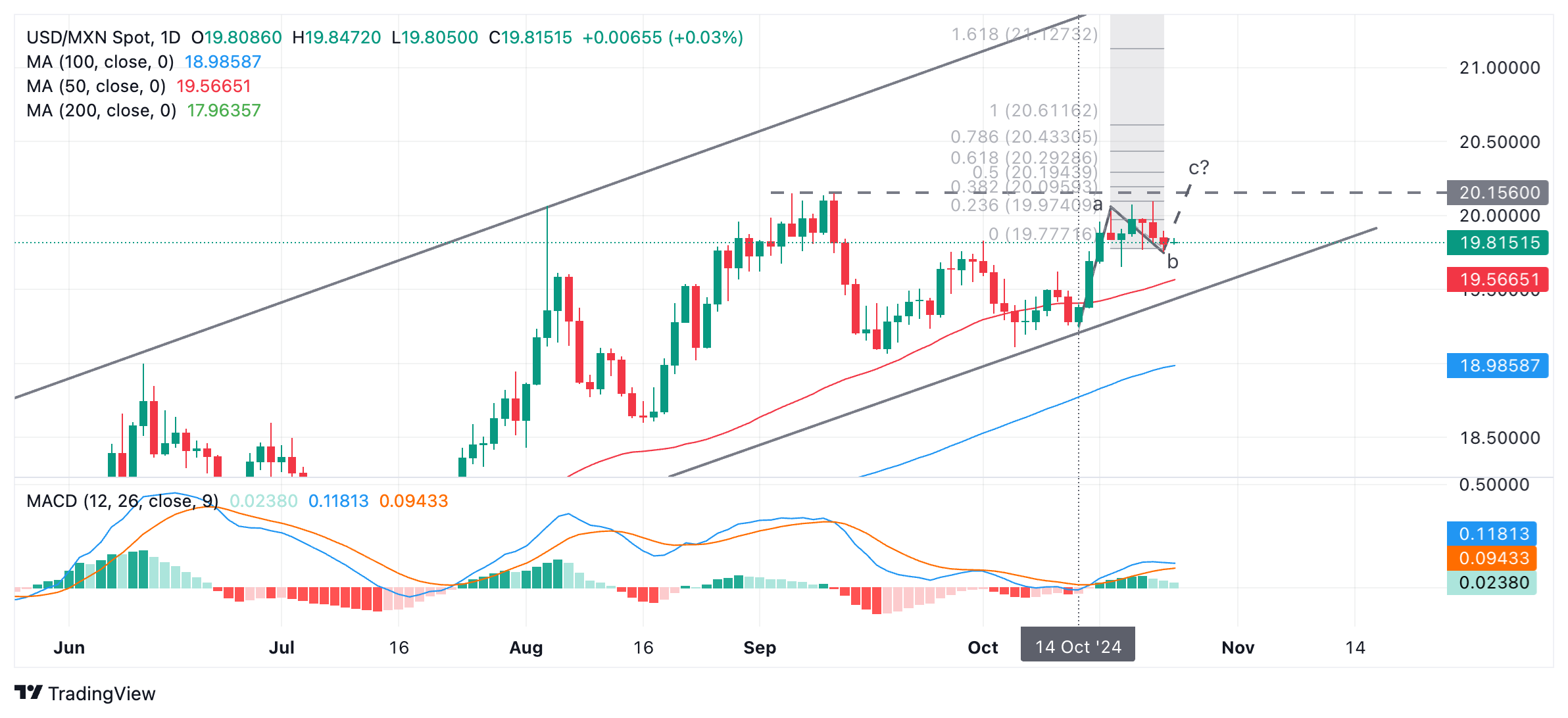
- The Mexican Peso pauses in its recovery amid rising chances of Donald Trump winning the US presidential election.
- Further attempts by deputies to limit the power of the Mexican judiciary also weigh on the Peso.
- USD/MXN pauses in its recent pullback and looks technically poised to begin a new leg higher, piercing the 20.00 level.
The Mexican Peso’s (MXN) recovery grinds to a halt on Friday as political risk in the form of US presidential election uncertainty and a new development in Mexico’s judicial-reform saga takes the wind out of bulls’ sails.
This adds to any weakness already caused by recent below-par macroeconomic data and any positive effects from a potential revival of the carry trade due to the depreciating Japanese Yen (JPY).
Mexican Peso falls foul to rise in political risk premia
The Mexican Peso is feeling the heat from the increasing chances that Republican nominee Donald Trump could win the US presidential election on November 5.
“Polls in the battleground states have remained very tight and within the margin of error,” says Jim Reid, Global Head of Macro Research at Deutsche Bank on Friday. “For instance, an Emerson poll of several swing states yesterday had Trump very marginally ahead, including a 1pt lead in Pennsylvania and Wisconsin, and a 2pt lead in North Carolina,” adds Reid.
Further, according to the model of leading US election website FiveThirtyEight, Trump now has a slightly higher 51% chance of winning. That said, the website’s master poll, which aggregates, averages, and weights polls according to recency, shows Harris still in the lead with 48.1% versus Trump’s 46.4%. Most betting websites also offer better odds of Trump succeeding.
A Trump win would spell trouble for the Mexican Peso. Trump has repeatedly said he will put higher tariffs on foreign imports and singled out the many cars manufactured and imported from Mexico for special treatment. Trump once said, in one interview with Bloomberg News, that he would slap tariffs of 100%, 200% or even 300% on Mexican autos.
Such a move, if Trump were to win, would cause a body blow to the Mexican economy, which has become heavily reliant on nearshoring manufacturing goods, especially autos, for the North American market. This is largely due to its free trade agreement with the US and Canada (up for renegotiation in 2026). It would also directly hit demand for the Mexican Peso from US importers.
Mexican Senate debates law to limit power of judiciary to block reforms
Investors in the West will probably also take a dim view of events taking place in the Mexican parliament, which could add further bearish pressure on the Mexican Peso. On Thursday, Mexican senators debated a possible ruling that would curtail the powers of the judiciary to impede reforms made by lawmakers in parliament.
“The Mexican Senate began the discussion of a ruling that seeks to establish the inadmissibility of appeals and controversies against reforms to the Constitution,” said Mexican financial news website El Financiero.
After a heated debate, in which opposition senators held up placards saying “NO A LA DICTADORA EN MEXICO,” the Senate voted by a majority of 85 for and 41 against to approve “in general and particular the opinion”.
“Although the opinion has the majority support of Morena and its allies the Labor Party (PT) and the Green Ecologist Party of Mexico (PVEM), the debate promises to be extended due to the resistance of the opposition parties, which insist that the measure puts at risk the balance of powers in the country,” said El Financiero.
If the ruling is approved, it would curtail the power of the judiciary to block laws made by parliament. Critics argue this would upset the balance of power in Mexico, whilst proponents argue the judiciary is biased and vulnerable to corruption.
Such a move would crystallize Western investors’ negative views regarding the reforms proposed by the left-leaning Morena government. This could risk stymying investment in the country, leading to softer growth and lower capital inflows into the Peso.
Technical Analysis: USD/MXN looks poised to begin new up leg
USD/MXN has stalled in its most recent pullback from the 20.00 barrier and looks poised to begin a fresh leg higher.
USD/MXN Daily Chart
Further supporting the bullish view is the strong evidence that USD/MXN is in an uptrend on a short, medium and long-term basis and is trading in a rising channel. Given the technical dictum “the trend is your friend,” the odds favor a continuation higher.
The pair may also be tracing out a bullish “abc” pattern since the October 14 swing low, with the “c wave” about to extend higher (see chart). If so, wave c would be expected to reach a length of a Fibonacci 61.8% of wave a, giving an upside target of 20.29. Such a move would gain confirmation from a break above the high of wave b at 20.09.
In addition, the original break above 19.83 (October 1 high) has confirmed a probable move up and a further target in the vicinity of the September 10 high at 20.13.
Mexican Peso FAQs
The Mexican Peso (MXN) is the most traded currency among its Latin American peers. Its value is broadly determined by the performance of the Mexican economy, the country’s central bank’s policy, the amount of foreign investment in the country and even the levels of remittances sent by Mexicans who live abroad, particularly in the United States. Geopolitical trends can also move MXN: for example, the process of nearshoring – or the decision by some firms to relocate manufacturing capacity and supply chains closer to their home countries – is also seen as a catalyst for the Mexican currency as the country is considered a key manufacturing hub in the American continent. Another catalyst for MXN is Oil prices as Mexico is a key exporter of the commodity.
The main objective of Mexico’s central bank, also known as Banxico, is to maintain inflation at low and stable levels (at or close to its target of 3%, the midpoint in a tolerance band of between 2% and 4%). To this end, the bank sets an appropriate level of interest rates. When inflation is too high, Banxico will attempt to tame it by raising interest rates, making it more expensive for households and businesses to borrow money, thus cooling demand and the overall economy. Higher interest rates are generally positive for the Mexican Peso (MXN) as they lead to higher yields, making the country a more attractive place for investors. On the contrary, lower interest rates tend to weaken MXN.
Macroeconomic data releases are key to assess the state of the economy and can have an impact on the Mexican Peso (MXN) valuation. A strong Mexican economy, based on high economic growth, low unemployment and high confidence is good for MXN. Not only does it attract more foreign investment but it may encourage the Bank of Mexico (Banxico) to increase interest rates, particularly if this strength comes together with elevated inflation. However, if economic data is weak, MXN is likely to depreciate.
As an emerging-market currency, the Mexican Peso (MXN) tends to strive during risk-on periods, or when investors perceive that broader market risks are low and thus are eager to engage with investments that carry a higher risk. Conversely, MXN tends to weaken at times of market turbulence or economic uncertainty as investors tend to sell higher-risk assets and flee to the more-stable safe havens.



